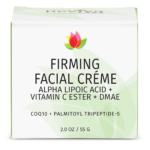Emulsion
Two dissimilar liquids homogeneously combined. Most face creams and conditioners, etc., are emulsions, and they are frequently held together with synthetic chemicals such as sodium lauryl sulfate, sorbitan palmitate, or one of the polysorbates. Another way to hold an emulsion together is with vigorous mixing.
An emulsion is a mixture of two or more liquids that are normally immiscible (unmixable or unblendable) owing to liquid-liquid phase separation. Emulsions are part of a more general class of two-phase systems of matter called colloids. Although the terms colloid and emulsion are sometimes used interchangeably, emulsion should be used when both phases, dispersed and continuous, are liquids. In an emulsion, one liquid (the dispersed phase) is dispersed in the other (the continuous phase). Examples of emulsions include vinaigrettes, homogenized milk, liquid biomolecular condensates, and some cutting fluids for metal working.

- Two immiscible liquids, not yet emulsified
- An emulsion of Phase II dispersed in Phase I
- The unstable emulsion progressively separates
- The surfactant (outline around particles) positions itself on the interfaces between Phase II and Phase I, stabilizing the emulsion
Two liquids can form different types of emulsions. As an example, oil and water can form, first, an oil-in-water emulsion, in which the oil is the dispersed phase, and water is the continuous phase. Second, they can form a water-in-oil emulsion, in which water is the dispersed phase and oil is the continuous phase. Multiple emulsions are also possible, including a "water-in-oil-in-water" emulsion and an "oil-in-water-in-oil" emulsion.
Emulsions, being liquids, do not exhibit a static internal structure. The droplets dispersed in the continuous phase (sometimes referred to as the "dispersion medium") are usually assumed to be statistically distributed to produce roughly spherical droplets.
The term "emulsion" is also used to refer to the photo-sensitive side of photographic film. Such a photographic emulsion consists of silver halide colloidal particles dispersed in a gelatin matrix. Nuclear emulsions are similar to photographic emulsions, except that they are used in particle physics to detect high-energy elementary particles.









